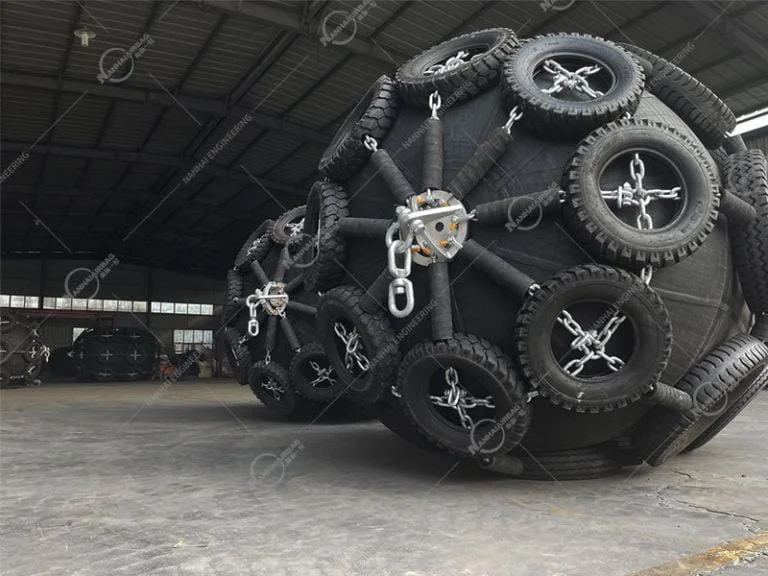What Kind of Ship Fenders Are Used on Floating Docks?
06/10/2025Overview of Rubber Fender Technology Development
06/11/2025Arrangement and selection of pneumatic rubber fenders
In the world of maritime transport, pneumatic rubber fenders play a vital role in protecting vessels and port infrastructure during berthing. These air-filled, durable cushions act as shock absorbers between ships and docks, ensuring that the energy from berthing is absorbed efficiently. As vessels increase in size and frequency, selecting the right marine fenders—and arranging them properly—is more important than ever.

Why Does the Arrangement and Selection of Fenders Matter?
Improper fender setup can lead to costly repairs and serious safety risks.
Imagine a busy coal terminal where large cargo ships berth daily. If fenders are too small or poorly positioned, the vessel’s hull may strike the concrete wall directly between fenders, causing structural damage to both the ship and dock. On the flip side, overspending on over-engineered fenders can unnecessarily inflate costs. That’s why it’s essential to understand how to choose and arrange ship fenders based on actual conditions like tides, dock shape, and vessel dimensions.
Types of Pneumatic Fenders and Their Applications
Each type of fender fits different marine operations and vessel types.
The most common types of pneumatic rubber fenders include:
- Net-type fenders – Surrounded by tire and chain nets, these are suitable for harsh conditions and frequent use.
- Sling-type fenders – Lighter and easier to handle, often used in lighter-duty or temporary applications.
Your choice should depend on whether you operate an oil terminal, ferry port, container terminal, or support ship-to-ship (STS) transfer.
Dockside Arrangement of Pneumatic Rubber Fenders
Fender layout must match real tidal and operational conditions.
The arrangement of marine fenders is closely related to the type of dock, tidal range, vessel size, and berthing angle. Here’s how to approach layout:
1. Vertical Arrangement on the Dock Face:
Fender height must account for tidal differences and ship hull height at various loading stages.
If the tidal range is large, floating fenders can supplement fixed ones to ensure safe contact regardless of sea level.
2. Horizontal Arrangement Along the Dock:
Fender spacing along the quay must reflect the berthing angle and vessel hull shape.
For straight quay walls, fenders are usually arranged at equal intervals.
Spacing should be carefully calculated by engineers. The goal is twofold:
- Ensure ships won’t strike the quay wall between fenders.
- Avoid overspending on excess units.
This balance guarantees safe yet economical berthing across various marine operations.
How to Choose the Right Pneumatic Rubber Fender
Don’t just rely on size—consider site-specific parameters.
Here are the key factors to consider when selecting a fender:
- Vessel size and hull shape
- Berthing velocity
- Water depth and tidal variation
- Frequency of berthing operations
- Type of docking infrastructure
- Local weather and wave conditions
Working with experienced marine rubber fender manufacturers can help you evaluate these factors and make informed decisions.
Mistakes to Avoid in Fender Selection and Arrangement
The wrong fender can cause more damage than protection.
Some common pitfalls include:
- Choosing fenders that are too short vertically in areas with high tidal changes.
- Using oversized fenders that can’t be installed securely on narrow docks.
- Placing fenders too far apart, leaving parts of the quay wall exposed during berthing.
Avoid these errors by consulting experts and always combining technical analysis with on-site realities.
Partnering with the Right Marine Rubber Fender Manufacturers
A good supplier offers more than just products—they deliver support.
Look for manufacturers who:
- Offer layout design and stress calculations
- Conduct site visits and consultation
- Provide documentation, testing, and after-sales services
Leading marine rubber fender manufacturers can tailor solutions that integrate pneumatic fenders, extruded rubber fenders, and floating systems to match specific project demands.
Conclusion: Right Fender, Right Layout, Right Outcome
Choosing and arranging pneumatic rubber fenders correctly isn’t just about compliance—it’s about protecting your investment and ensuring smooth operations. Whether you’re outfitting a new port or upgrading an aging terminal, take time to plan fender selection and placement carefully. Work with professionals, and you’ll save time, money, and potential damage down the line.
People Also Ask (Related Questions for Google)
These FAQs help improve SEO and provide additional value to readers:
What are the different types of marine rubber fenders?
Marine rubber fenders include pneumatic, cone, cylindrical, arch, and extruded types—each suited for different berthing needs.
How do I choose the right pneumatic fender for my ship?
Consider vessel size, docking location, berthing angle, and tidal range. Consult a marine rubber fender manufacturer for guidance.
How should ship fenders be arranged on a dock?
They should be arranged based on vessel shape, tidal variation, and docking method—both horizontally and vertically.
What’s the difference between extruded rubber fenders and pneumatic fenders?
Extruded fenders are fixed solid profiles; pneumatic fenders are air-filled and flexible, better for high-energy absorption and floating berths.
Who are the top marine rubber fenders manufacturers?
Look for certified suppliers with global service networks and experience in both custom and large-scale marine projects.
